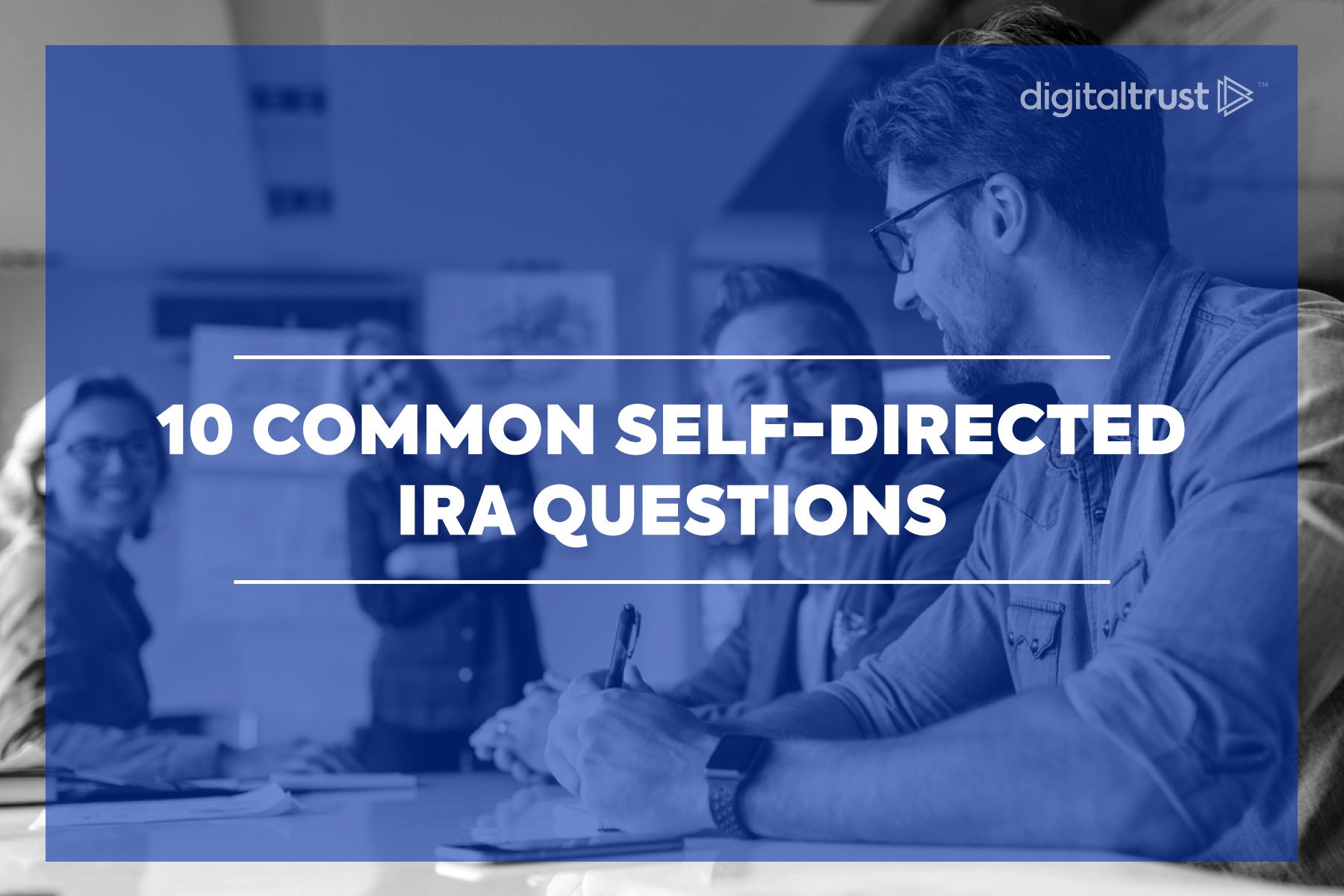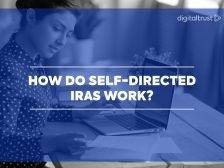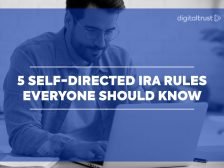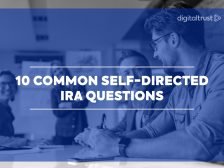The world of self-directed investing with a SDIRA can seem complicated at first, but it can also be well worth the learning curve once your account is set up and running. Whether you’re just getting started or you’ve been investing with a self-directed account for years, it’s helpful to know the basics.
To better serve you, we’ve put together 10 of the most commonly asked questions we’ve come across regarding Self-Directed IRAs:
1. What is the difference between a Self-directed IRA (SDIRA) and an IRA at your local bank or brokerage?
Technically, there is no legal distinction between a self-directed IRA and any other IRA. “Self-directed” is simply a term used to help describe an account that allows the investor to have full control over his/her investment choices.
The difference between them is that with a truly self-directed IRA, investment options can seem almost boundless, just as long as you steer clear of the IRS’s prohibited assets. With an SDIRA, you’ll have access to alternate investments in addition to just the institution’s given selection of assets.
2. What are the benefits to utilizing a self-directed IRA?
There are many benefits when it comes to self-directed IRAs. First and foremost, are the tax protections that they can provide. Depending on the type of account you have, you can either defer tax (through a Traditional IRA) until you retire and take distributions or pay the tax up front (with a Roth IRA) and enjoy years’ worth of potential tax-free growth.
An SDIRA can encourage or even empower you to diversify your portfolio by expanding your investment choices beyond stocks, CDs, and mutual funds, providing you with more control over the investments you choose. This enables you to invest in the things you may know and understand as opposed to things you may not be as familiar with.
3. What types of IRAs are there?
Of the commonly asked IRA questions is the one regarding the types of IRAs available. There are several retirement account options available to you. While some offer larger annual contributions, others allow for potential tax-free distributions. Here’s a brief overview on how they differ:
Traditional IRA
In this type of account, contributions are typically tax-deductible because taxes on IRA earnings are not incurred until the account holder takes a distribution of funds from the IRA. At that time, IRA withdrawals are taxed as income.
Roth IRA
With a Roth IRA, contributions are made with after-tax funds, as they are not tax-deductible. Earnings and withdrawals are tax-free, however.
SEP IRA
A simplified employee pension (SEP) IRA enables an employer, usually a small business or self-employed person, to make retirement contributions through a traditional IRA that is in the employee’s name.
SIMPLE IRA
This type of IRA is similar to an employer-sponsored 401(k). It’s offered to small businesses, which lack a retirement savings plan. A Savings Incentive Match Plan for Employees (SIMPLE) IRA lets both an employer and an employee make contributions. Simple IRAs sometimes considered to be less complicated than 401(k) plans and also entail lower contribution limits.
Check out our Self-Directed IRA Plan Comparison chart for more insight on how each type of IRA differs.
4. Which types of investment assets are prohibited in a self-directed IRA(SDIRA)?
Essentially, only the IRS can determine which assets are prohibited within an IRA.
Under current law, a retirement account is restricted from investing in the following:
- Collectibles such as: Art, stamps, coins, alcoholic beverages, or antiques (IRC 408(m));
- Life insurance (IRC 408(a)(3));
- S-corporation stock, (IRS Letter Ruling 199929029, April 27, 1999, IRC § 1361 (b)(1)(B));
- And, any investment that constitutes a prohibited transaction pursuant to ERISA and/or IRC 4975 (e.g. purchase of any investment from a disqualified person such as a close family member to the retirement account owner).
5. What are the most popular self-directed retirement investments?
As listed above, there are only a handful of asset types that account holders cannot invest in through their self-directed IRAs. Thus, these assets aside, you are left with a nearly endless array of investment options. The most popular assets with our clients are:
- Real estate & rental properties;
- Secured loans to others for real estate (trust deed lending);
- Private small business stock or LLC interest; and
- Precious metals, such as gold or silver.
6. Which supporting documents do I need to purchase an investment in my account?
The supporting documents needed to purchase an investment vary based on the type of investment being purchased. Here are a few examples that showcase the required documents for various types of assets:
Real Estate
All documents associated with the purchase of real estate: Purchase Agreement, Appraisal / Broker Opinion Letter, etc.
Limited Partnerships
Copy of Tax ID, Certificate of Limited Partnership, and Limited Partnership Agreement signed by all Partners
Private Stock / C-Corporation
Copy of Tax ID, Articles of Incorporation, By-Laws, Subscription/Stock Purchase Agreement; All original stock certificates must be physically held by Digital Trust
Promissory Note / Mortgage
Copy of Promissory Note/Mortgage and Security Interest; I.e., Deed of Trust, Deed of Mortgage, and Security Agreement
Limited Liability Company
Copy of Tax ID, Articles of Organization, and Operating Agreement signed by Members
Private Placement Memoranda (“PPM”)
A copy of the PPM, Operating Agreement, and Subscription Agreement
The investment possibilities with a Self-Directed IRAs are virtually endless. Take a moment to check out a wide variety of investment options that are available through a self-directed IRA.
7. Can I live in or work on a house that my IRA owns?
No, unfortunately not. You, or any other disqualified person, may not have any personal use or benefit of the property while it is held in your IRA account. The property is to be purchased for investment purposes only.
8. Can my account invest with other partners, including myself?
Yes, your IRA can invest with other partners and yourself, individually. However, it is important to consult legal counsel in these situations to be made aware of formalities and rules, such as Prohibited Transactions and Disqualified Persons, that may be associated with the shared investment.
9. What is a Prohibited Transaction?
The Internal Revenue Code Section 4975 defines a prohibited transaction as any improper use of your retirement account. Additionally, a transaction between your IRA account and a disqualified person is a prohibited transaction.
10. What is a disqualified person?
Disqualified Persons are defined to be the account owner, other fiduciaries, certain family members (lineal descendants and spouses of lineal descendants), and businesses under the account owners or disqualified person’s control. Generally, a “disqualified person” includes, but is not limited to:
- Yourself
- Your lineal ascendants and descendants
- The spouse of a lineal descendant
- Your spouse
- Any entity that is owned 50% or more by disqualified persons
- An entity that is controlled 50% or more by disqualified persons
Please review the code for specific information and definitions. Other useful IRS resources are:
- Publication 590-A – Contributions to Individual Retirement Arrangements (IRAs)
- Publication 590-B – Distributions from Individual Retirement Arrangements (IRAs)
- Publications 560 – Retirement Plans for Small Business (SEP, SIMPLE and Qualified Plans)
(Bonus) 11. Do I need an LLC to purchase investments in a self-directed IRA?
No, you do not need to create any LLC when using an IRA to invest. When using your IRA to purchase alternative investments, you can simply provide the custodian with the requisite purchase documents to let them know what asset you would like to purchase. Your custodian will then process the paperwork to purchase the investment in the name of your IRA.
Conclusion
While self-directed IRAs may not be the easiest thing to understand, at first, they can be with a little help and a bit more time. And after this article and perhaps, more articles like this, you can be better equipped to get started with confidence. That said, it’s important to have a knowledgeable investment professional or a certified IRA custodian/specialist that can help answer questions when needed!
Have more IRA questions in mind? Or if you’d like to learn more about how you can get started investing with a self-directed IRA, our team of experts are here to help. Call us today at (800) 777-9878 or email us at [email protected].



